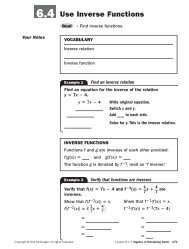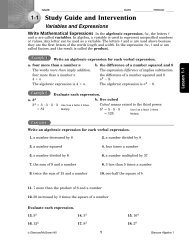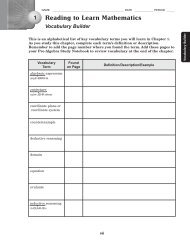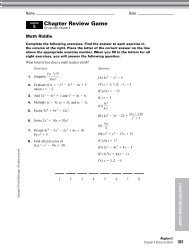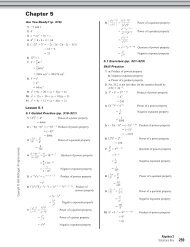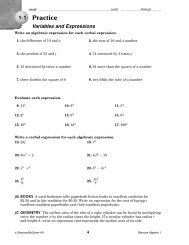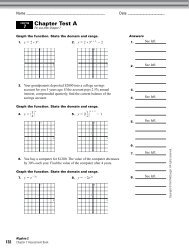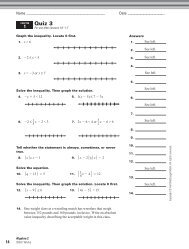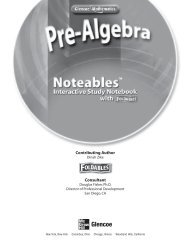real-world applications - MathnMind
real-world applications - MathnMind
real-world applications - MathnMind
Create successful ePaper yourself
Turn your PDF publications into a flip-book with our unique Google optimized e-Paper software.
NAME _______________________________________________________ DATE _____________________________________<br />
REAL-WORLD APPLICATIONS<br />
STUDENT ACTIVITY for Transparency 8<br />
Use with Lesson 8-3.<br />
About Those Massive Planets<br />
Our Sun and the nine planets in our solar system may have been formed about 5 billion years<br />
ago. The first four planets from the Sun—Mercury, Venus, Earth, and Mars—are called the<br />
terrestrial planets. These planets all have magnetic fields, solid surfaces, and are comparatively<br />
dense. The five outer planets—Jupiter, Saturn, Uranus, Neptune, and Pluto—are spheres of<br />
hydrogen and other gases. Four of these planets—Jupiter, Saturn, Uranus, and Neptune—called<br />
the gas giants, are much larger than the terrestrial planets. Pluto, the most distant planet, is a<br />
ball of frozen gases. Pluto is also the smallest planet; it is about the size of our Moon.<br />
People began studying the planets thousands of years ago. Until Galileo built his own telescope<br />
in 1609, characteristics such as the rings of Saturn or Jupiter’s moons were unknown. Improved<br />
technology has made study of the planets much easier. However, many questions about planets<br />
and their environments remain unanswered.<br />
Directions: Use what you have seen and read to answer the following questions.<br />
1. What is the relationship between the mass of Mars and the mass of Earth?<br />
about 0.1 of the mass of Earth.<br />
The mass of Mars is<br />
2. Select two planets whose masses are written using the same exponent. Compute the difference in the<br />
masses of the two planets. Sample answer: The difference between the masses of Earth<br />
and Venus is 1.11 1024 kilograms.<br />
3. Which planet has the greatest mass? What is the mass of that planet relative to that of Earth?<br />
Jupiter; the mass of Jupiter is about 300 times the mass of Earth.<br />
4. The mass of the Sun is 1,828,800,000,000,000,000,000,000,000,000 kilograms. How many times<br />
greater than the mass of Earth is the mass of the Sun? The mass of the Sun is about 3 106 times greater than the mass of the Earth.<br />
Making the Connection<br />
5. Compare the mass of Jupiter to the total of the masses of the other planets.<br />
about 2.5 times the sum of the masses of the other planets.<br />
Jupiter’s mass is<br />
6. What does its density tell about a planet? What types of units are used to express density? Use a<br />
reference to find the densities of the planets. How do the densities of the terrestrial planets compare<br />
to the densities of the gas giants? A planet’s density is its mass per unit volume.<br />
Densities in ounces per cubic inch are: Mercury, 3.13; Venus, 3.03; Earth 3.19;<br />
Mars, 2.27; Jupiter, 0.759; Saturn, 0.40; Uranus, 0.7; Neptune, 1.0; Pluto, 0.2.<br />
Terrestrial planets have greater densities.<br />
© Glencoe/McGraw-Hill T8 Glencoe Algebra 1



